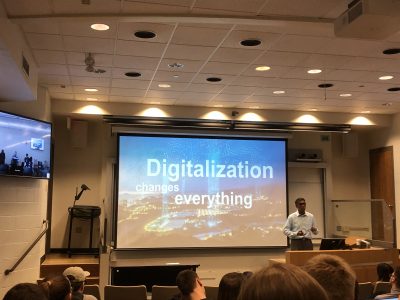On May 2nd, The CTIN4SPIRE Manufacturing Ingenuity series hosted Shankar Raman from Siemens, where he gave a talk entitled, “Rise of the Digital Twin.” Shankar is the Director of Digital Manufacturing in Portfolio Development at Siemens, and has over 25 years of experience in the product life cycle industry.
To begin his talk, Shankar began by describing the overwhelming presence and power of digitalization in the world today. Digitalization has the power to change entire business models, change company dynamics, and connect all entities of a single company together on a virtual scale. While only 3.5% of factories worldwide are connected today, 62% of current industry CEOs have already-set initiatives to make their company more digital, 61% said IoT is expected to play a role in organizations and will provide a foundation for digital business strategies, and 48% of organizations that are already implementing IoT, stated that they are already using or are planning to use Digital Twin in the upcoming year.
While the ideology of connecting multi-billion dollar industries together virtually has become a top priority for many CEO’s, current prediction states that more than 50% of companies that attempt to move to a completely digital model will fail. Shankar explained some of the reasons for this failure, citing examples such as the digital platform not being central to corporate strategy, that companies perceive digital as only a tool for back-office efficiency, and that these companies are not targeting the necessary organizational and cultural changes necessary to implement a change of this magnitude. To survive this disruption and beat this failure, Shankar provides a potential solution to this problem, citing that incumbents need to become digital enterprises, rethinking every element of their business.
The Digital Twin is defined as, “a comprehensive integrated virtual representation of a product, a process, or an asset,” that can allow individuals to understand, predict, and optimize all parts of the production and design process. This technology also ties together the concepts of ideation, realization and utilization, which all blur together due to the ubiquitous nature of innovation. There have been many successful examples of the digital twin in action worldwide, such as generative design, product validation, line and process planning, human engineering modeling, virtual commissioning, and production execution.
Sankar ended his talk by describing the variety of problems that can be solved through the use of the digital twin, both for the end-customers and for the OEM and equipment suppliers. From the perspective of the end-customer, this technology can help optimize asset operation, increase uptime, improve maintenance, and optimize energy efficiency, while simultaneously lowering warranty expenses, increasing service efficiency, and providing additional services on the end of the OEM and equipment suppliers.
